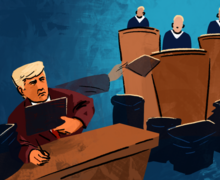Scholars discuss ongoing Iranian political uprising at Maxwell panel
Anshul Roy | Staff Photographer
One expert referred to the current protests in Iran as the nation’s first feminist uprising and said the movement is demanding recognition of basic human dignity and liberty.
To support student journalism and the content you love, become a member of The Daily Orange today.
The Moynihan Institute of Global Affairs at Syracuse University held a virtual panel discussion Tuesday afternoon on the recent political uprising in Iran.
Pedram Maghsoud-Nia, formerly an assistant director of SU’s Middle Eastern Studies program, moderated the panel discussion. Panelists included Arzoo Osanloo, a professor and the director of University of Washington’s Middle East Center, and Kian Tajbakhsh, a senior adviser at Columbia University’s Global Centers.
Mahsa Amini, a 22-year-old woman who was visiting Tehran at the time, died Sept. 16 in police custody after allegedly violating Iran’s hijab law. Her death sparked protests throughout Iran, with demonstrators demanding an end to violence against women and the requirement to wear a hijab. At SU, the Iranian Student Association held a vigil in front of Hendricks Chapel on Sept. 27 in the wake of Amini’s death.
Osanloo said the country’s current political unrest is much more than people advocating for women’s rights and bodily integrity. Instead, she said, it is the product of accumulated grievances that have gone unanswered by the current Iranian regime.
“It’s also a metaphor for the feeling of the body under siege, a sense of feeling beleaguered, with no clear avenues for reform and sadly, for some, less and less to lose,” Osanloo said.
In a Sept. 28 Public Seminar essay, Tajbakhsh referred to the current protests in Iran as the nation’s first feminist uprising and said the movement is demanding recognition of basic human dignity and liberty. While there have always been such demands from minority ethnic groups, Tajbakhsh said Tuesday that current protests are transcending group identity.
Tajbakhsh also pointed to the fact that Iran is one of the only two countries in the world that imposes mandatory hijab veiling on all women in public. He also noted that the Islamic dress code is technically enforced on both men and women in the country.

Even among more religious people and those who support the Iranian government, Tajbakhsh said there has been widespread disagreement with the policy.
“In the social realm in Iran, it’s become such an anachronism that it’s almost becoming like an embarrassment,” Tajbakhsh said.
Osanloo disagreed with some of Tajbakhsh’s remarks, saying that while the veiling law is imposed on both men and women on paper, the discriminatory enforcement of the law almost always targets Iranian women.
Tajbakhsh also said many protestors are in their late teens and 20s. The generational divide has profound historic meaning for the Iranian regime, he said.
“This is a generation that has grown up only within the confines of the ideological parameters of the Islamic Republic of Iran,” Tajbakhsh said. “So the idea that this generation is turning its back on the values that it grew up (with) and was indoctrinated must rattle the regime.”
Osanloo said the current movement won’t be short-lived. While people with a western perspective may view the current uprising in Iran as lacking clear objectives and organization, Osanloo said “non-collective” actors are important for social movements in a highly-centralized authoritarian state.
“What we are seeing here is a generational clash among a young generation that feels utterly alienated from the leaders and from their grandparents as it were,” Tajbakhsh said. “And they are pushing against this patriarchal system, which is being held up by the Islamic regime and Islamic system as a form of public morality.”
Tajbakhsh believed the regime will prevail over the protests in the short-term considering there haven’t been any signs of military and security forces siding with the protestors.
The Iranian regime responded to some of the protests with force, some of which were fatal, Tajbakhsh said. He added that the regime has been hesitant to carry out its force to its potential because increased fatalities among young people would be a “complete disaster.”
Tajbakhsh said what is unfolding in Iran could be understood as a full-fledged culture war. He added that people should resist thinking the current protests as binary between an oppressed society and an oppressive state.
Osanloo again disagreed, saying that while some of the current protests can be interpreted as a culture war to some extent, state leaders have received them as a political challenge, ultimately causing increased tension.
Osanloo also said that although there is very little support for compulsory hijab, it’s unlikely that the Iranian government will lift the mandate overnight as it is the same government that politicized the hijab as the symbol of the success of the 1979 revolution.
“If the hijab goes, so goes the state in so many aspects,” Osanloo said.
Published on October 12, 2022 at 12:42 am
Contact Francis: btang05@syr.edu | @francis_towne





